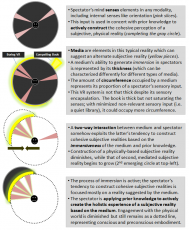
Describing media as ‘immersive’ is ambiguous. From debilitating addiction to therapeutic relief, media engagement holds a clear duality in its effect on humanity…
Without an interdisciplinary characterization of “immersion”, why do we allow this concept to be so readily invoked in discussions of books, visual art, video games, virtual reality systems and more?
While “immersion” into traditional media concerns the contemplative distance of a spectator to another world depicted in a written novel or work of art, contemporary technologists can speak in terms of a virtual distance which has a perceptual element. If engaged in the social interactions and perceptual attributes of a novel’s image-less, textual world, is the reader “immersed”? Alternatively, if participants enter a highly functional VR system, with a head-mounted display, spatialized audio and haptic feedback, but do not believe the illusion, are they “immersed”?
The ambiguity surrounding “immersion” is a significant obstacle to researching media which lie across literature, art and technology. The present dialectic moves from phenomenological boundaries between self, world and other worlds to theoretical similarities between “immersion” as discussed by traditional and interactive media theorists. A unifying characterization is established and discussed in the context of an ongoing project which explores boundaries of what is considered “immersive”: the Sonic Cradle, a chamber combining biofeedback, sensory deprivation, music and meditation.
Watch a presentation of the cross-disciplinary ‘immersion’ framework below:

» Learn more about ‘Sonic Cradle’, a human-computer interface which was inspired by the framework